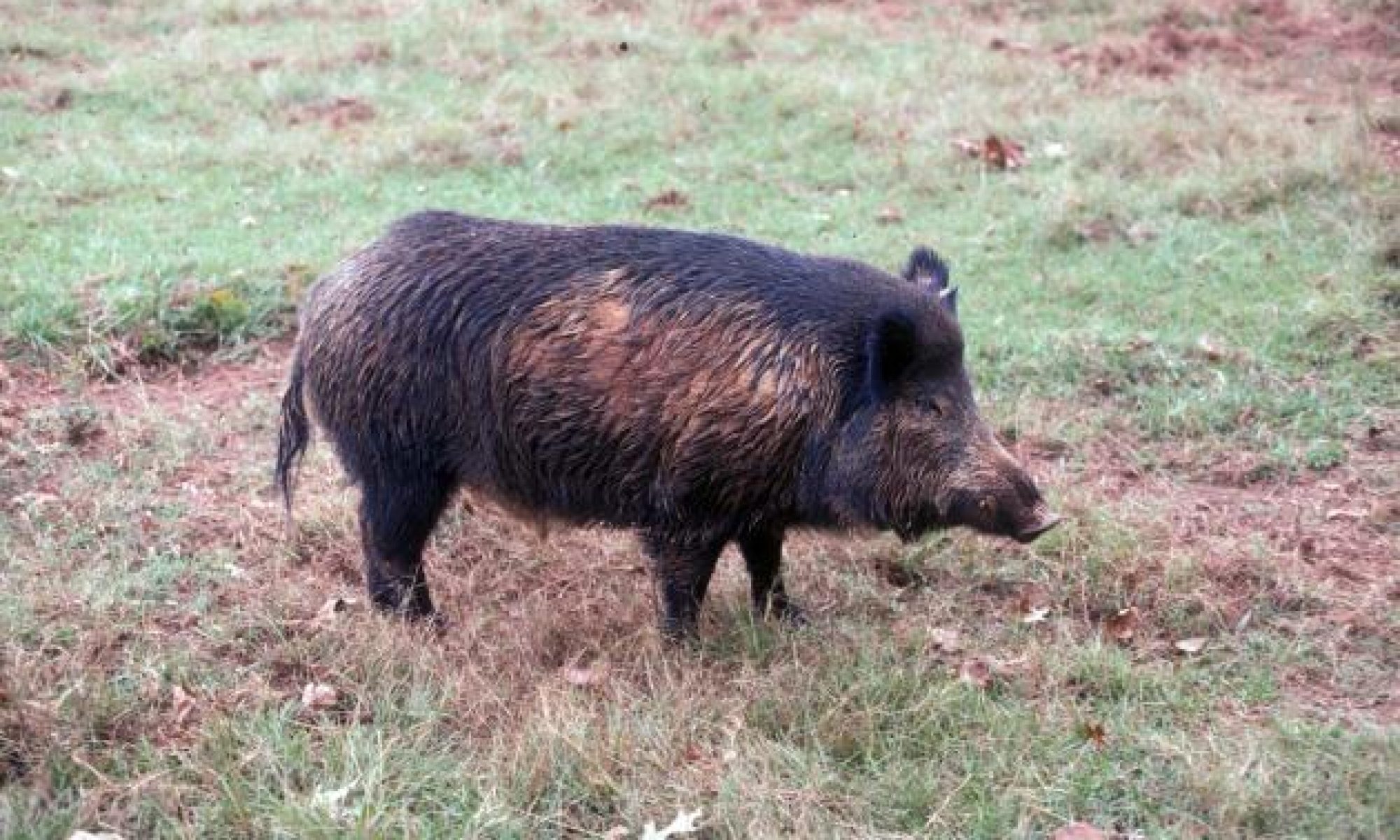Feral hogs (also called wild hogs or wild pigs; Sus scrofa) are omnivorous and very opportunistic in their food habits. Their feeding behavior is one of the main reasons why this species has been so successful in establishing new populations in areas previously without feral hogs. The year-round diet of feral hogs is composed primarily of plants with smaller amounts of algae, fungi, animals, and other material (Fig. 1). Their diet depends on food availability. The types of food available in a particular location during a season typically determines the bulk of their diet. Feral hogs tend to maximize their intake of a preferred food resource when it is encountered. These factors can result in abrupt and radical changes in diet as new foods become seasonally available or encountered.

Figure 1. Composition of a typical feral hog diet. (Illustration courtesy of Jack Mayer.)
The feral hog’s digestive system is essentially identical to its domestic counterpart. The stomach is a simple, non-ruminating, two-chambered structure with a small blind pouch. The stomach capacity of an adult feral hog is about 5 to 8 quarts. These animals will eat daily about 3-5% of their total body weight.
Most studies find no differences in feral hog diets with respect to gender or age, though sometimes local hog populations vary in their diets. Some studies report differences in diet for younger hogs. Several studies report a greater proportion of animal material in the stomachs of young feral hogs compared to adults. Younger hogs may also eat a greater overall diversity of foods. This dietary diversity was suggested as an advantage for these young and inexperienced animals, which were still learning to cope with fluctuations in food availability in the local area.
Hogs forage in several ways:
(1) browsing and grazing – leaves, fronds, stems, etc.
(2) foraging on the ground – fruits of woody species, fungi, small animals, vertebrate carrion, etc.
(3) rooting – rhizomes, tubers, bulbs, corms, invertebrate larvae, small fossorial vertebrates, etc.
Feral hogs normally rely on a keen sense of smell to identify potential food items. Most food they consume is at or near ground level. Feral hogs are extremely adept at rooting to locate potential food below the soil surface.
Plant Consumption
Feral hogs consume plants year-round. Plant consumption can vary seasonally from 50-100% of their daily diet. The number of plant species consumed by feral hogs is considerable. Feral hogs will consume the fruits, seeds, leaves, stems, shoots, bulbs, tubers, and roots of plants. The makeup of this varies significantly by location. The general plant groups consumed by these animals collectively include mosses, ferns, horsetails, conifers, and flowering plants. Native plants comprise most of the feral hog diet. Of the various species of plants consumed, mast (acorns, beechnuts, chestnuts, and hickory nuts) appears to be most important and preferred. Subsurface herbaceous materials, including roots, tubers, bulbs, etc., are widespread and important staples in feral hog diets throughout their distribution. Feral hogs tend to prefer fleshy roots or corms to woody roots. Because of their relatively high digestibility and concentration of individual plants, agricultural crops are a highly preferred food resource for feral hogs when available. The commercial crops eaten by these animals variously include grains/cereals (wheat, sorghum, barley, hay, rye, oats, millet, maize/corn, and rice), vegetables (various potatoes, yams, squash, turnips, rutabagas, beets, cassava, lettuce, cabbage, beans, peas, soybeans, and artichokes), fruits (pumpkins, grapes, blueberries, pineapples, avocados, bananas, apples, various citrus species, watermelons, cantaloupes, and coconuts), and other cultivated species (cotton, linseed, sunflower, peanuts, almonds, oilseed/rapeseed, groundnuts, pecans, clover, thyme, basil, oil palms, sugar cane, rubber seeds, padi, and turf/sod/pasturage).
Algae Consumption
In coastal habitats, feral hogs opportunistically consume green and brown seaweeds on exposed shores. Consumption is limited to feral hogs living in locations where green and brown seaweeds are accessible. Given the range of feral hogs in the United States, algae is a minor component of the overall feral hog diet in this country (Fig. 1).
Fungi Consumption
Feral hogs consume a small amount of fungi, specifically the fruiting bodies of fungi, year-round (Fig. 1). The amount consumed depends on availability of other forage resources.
Animal Consumption

Figure 2. Feral hogs will prey on deer fawns.
Animal consumption typically is a smaller percentage of the diet (Fig. 1). Almost all studies of feral hog diets report the presence of at least some animal matter. Animal matter (including invertebrate and vertebrate species) is consumed year-round. Feral hogs will consume earthworms, arachnids, crustaceans, insects, myriapods, gastropods, nematodes, fish, amphibians, reptiles, birds, and mammals. Feral hogs will also eat the egg, larval/immature and adult forms, as well as the remains or carcasses of these species. Predation is directed at either young animals or less mobile species (Fig. 2). Given the opportunistic nature of feral hogs, the effect of feral hog depredation on any one species is typically minor.
Other Foods
Feral hogs ingest a small volume of other materials (Fig. 1). Garbage includes both edible (discarded food waste) and inedible (e.g., plastic, rubber bands) refuse. Biotic materials include pieces or lumps of wood, peat, and lichen that have been either intentionally or unintentionally ingested. Rooting is believed to result in the incidental ingestion of trace amounts of soil (sand) and rocks (gravel). The presence of geological materials varies from trace amounts to as much as 5.3% of their annual diet by volume.
Competition with Wildlife Species
Feral hogs compete with deer, wild turkey, black bear, and squirrels for acorns. Acorns are readily consumed by feral hogs. Feral hogs have been observed to aggressively exclude deer from feeding on acorns in localized areas. Research about dietary overlap between wildlife and feral hogs has failed to indicate whether competition for a limiting resource occurs. If competition occurs, the effects would be worse in years with a poor acorn crop.
